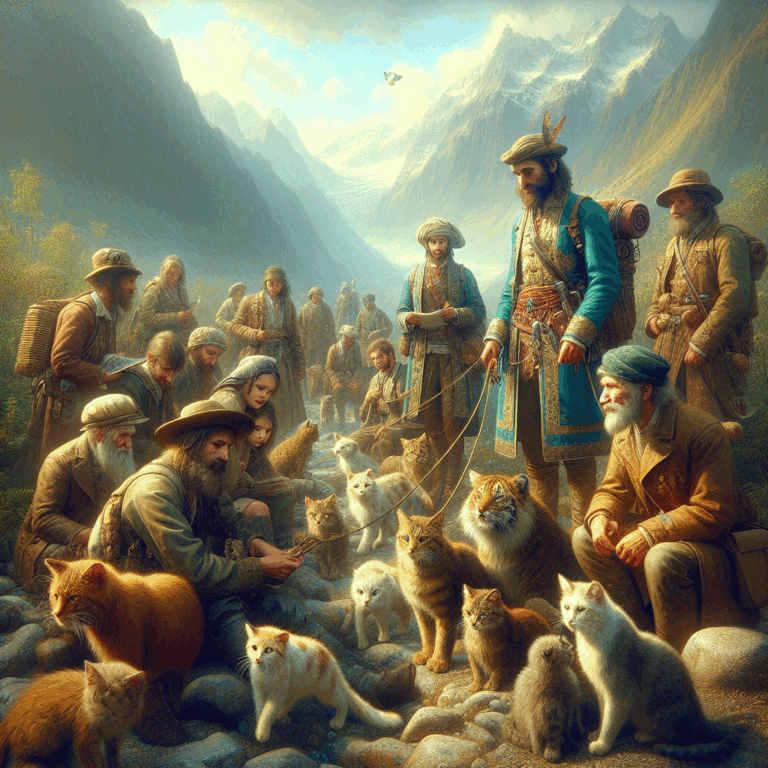The Feline Adventurers: Cats and Their Role in Historical Expeditions
- 2 Comments
For centuries, cats have been known as steadfast companions to humans, but their participation in historical expeditions offers a fascinating glimpse into their adventurous spirit and adaptability. From the high seas to uncharted territories, cats have played a crucial role in aiding explorers and contributing to the success of their daring voyages.
The Age of Exploration, spanning from the 15th to the 17th centuries, marked a time of significant global discovery. During these voyages, ships were often plagued by the presence of rodents, which posed a threat to food supplies and the health of the crew. Enter the ship’s cat, a vital crew member tasked with controlling the rodent population. Cats like these were not just practical additions to the crew; they also provided companionship and a morale boost to sailors who spent months at sea.
One of the most famous ship’s cats was Trim, who accompanied the British navigator Matthew Flinders on his voyages to circumnavigate Australia. Trim’s presence was more than a comfort to the crew; he became a symbol of resilience and bravery. His adventures were chronicled by Flinders, who described Trim as a “sportive little fellow” who was as much a part of the expedition as any human crew member.
Cats also found their way onto polar expeditions, where their acute hunting skills helped protect vital food stores. In the harsh, icy environments of the Arctic and Antarctic, cats provided warmth and companionship, fostering a sense of home amid the desolation. This connection between explorers and their feline companions highlighted the universal need for comfort and familiarity in the face of the unknown.
Beyond their practical roles, cats became mascots and symbols of hope for many expeditions. Their ability to adapt to new and challenging environments mirrored the explorers’ own aspirations to conquer uncharted territories. Cats’ innate curiosity and fearlessness in the face of new surroundings made them ideal companions for those venturing into the unknown.
In more recent history, cats have continued to accompany explorers, scientists, and adventurers on their quests. From mountain climbers to desert trekkers, the presence of a feline companion often provides a psychological boost, reminding those on arduous journeys of the comforts of home and the simple joys of companionship.
The legacy of cats in exploration is a testament to their enduring bond with humans. Their roles in historical expeditions showcase not only their physical capabilities but also their ability to inspire courage and resilience. As we continue to explore new frontiers, whether on Earth or beyond, it is likely that cats will remain by our side, ever curious, ever adventurous, and ever ready to embark on the next great journey with us.

For centuries, cats have been known as steadfast companions to humans, but their participation in historical expeditions offers a fascinating glimpse into their adventurous spirit and adaptability. From the high seas to uncharted territories, cats have played a crucial role in aiding explorers and contributing to the success of their daring voyages.
The Age of Exploration, spanning from the 15th to the 17th centuries, marked a time of significant global discovery. During these voyages, ships were often plagued by the presence of rodents, which posed a threat to food supplies and the health of the crew. Enter the ship’s cat, a vital crew member tasked with controlling the rodent population. Cats like these were not just practical additions to the crew; they also provided companionship and a morale boost to sailors who spent months at sea.
One of the most famous ship’s cats was Trim, who accompanied the British navigator Matthew Flinders on his voyages to circumnavigate Australia. Trim’s presence was more than a comfort to the crew; he became a symbol of resilience and bravery. His adventures were chronicled by Flinders, who described Trim as a “sportive little fellow” who was as much a part of the expedition as any human crew member.
Cats also found their way onto polar expeditions, where their acute hunting skills helped protect vital food stores. In the harsh, icy environments of the Arctic and Antarctic, cats provided warmth and companionship, fostering a sense of home amid the desolation. This connection between explorers and their feline companions highlighted the universal need for comfort and familiarity in the face of the unknown.
Beyond their practical roles, cats became mascots and symbols of hope for many expeditions. Their ability to adapt to new and challenging environments mirrored the explorers’ own aspirations to conquer uncharted territories. Cats’ innate curiosity and fearlessness in the face of new surroundings made them ideal companions for those venturing into the unknown.
In more recent history, cats have continued to accompany explorers, scientists, and adventurers on their quests. From mountain climbers to desert trekkers, the presence of a feline companion often provides a psychological boost, reminding those on arduous journeys of the comforts of home and the simple joys of companionship.
The legacy of cats in exploration is a testament to their enduring bond with humans. Their roles in historical expeditions showcase not only their physical capabilities but also their ability to inspire courage and resilience. As we continue to explore new frontiers, whether on Earth or beyond, it is likely that cats will remain by our side, ever curious, ever adventurous, and ever ready to embark on the next great journey with us.



2 thoughts on “The Feline Adventurers: Cats and Their Role in Historical Expeditions”
What an interesting perspective on the friendship and contributions of cats to explorers throughout history!
What a fascinating exploration of the adventurous roles cats have played in history!